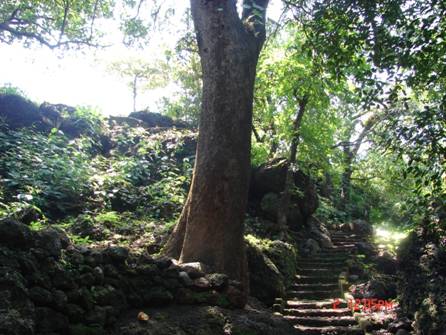/topics/sustainability
Sustainability
Training course on livelihood enhancement through sustainable natural resource management in drylands, ICAR, 17th Feb to 2nd Mar 2011, Hyderabad
Posted on 24 Jan, 2011 12:33 PMOrganizer: Indian Council for Agricultural Research
Venue: Central Research Institute for Dryland Agriculture (CRIDA), Santoshnagar, Hyderabad
Sustainable water management initiatives in Konkan under threat - A report
Posted on 21 Jan, 2011 02:09 PMGuest Post by: Parineeta Dandekar
At the first sight, Daarche Paani (‘water at the doors’) appears unreal.. on a small flat plateau called ‘Sadaa’ in konkan, an elegant cobbled walkway leads a puzzled visitor to stairs carved in stone, which go down to an ancient grove, and here is an intricate system of tanks, channels and falls which supplies water to the Panderi village and goes down as a free flowing stream, to irrigate a plantation of arecanut, pepper and mangoes in a village called Gudaghe. When I visited the place, I could see three eminent visitors, a silent lady washing her load of clothes, a fairy bluebird splashing at a tank and a huge moonmoth in one of the trees.
 Stone walkway and ancient mango trees leading to Daarche Paani.
Stone walkway and ancient mango trees leading to Daarche Paani.
Photo: Parineeta Dandekar
The Bhoomi Conference - 2011, Jan 21 & 22, Bangalore
Posted on 19 Jan, 2011 01:41 PM
Organizer: Bhoomi Network for Sustainable Living
Venue: St. John's Auditorium, Koramangala, Bangalore
24th national convention of IPHE (India) on "Water & sanitation utility services in India and their health implications" held in Bhubaneshwar
Posted on 18 Jan, 2011 11:49 PMThe 24th National Convention of Institution of Public Health Engineers (India) on the theme “Water & Sanitation Utility Services in India and their health implications” will be organised by IPHE(I), Regional Centre, Bhubaneswar during 12th -13th February,2011.
Eastern Himalaya freshwater biodiversity assessment report released by IUCN and Zoo Outreach Organisation
Posted on 18 Jan, 2011 11:44 PMDear all,
IUCN, with Zoo Outreach Organisation, have today published a new report, 'The status and distribution of freshwater biodiversity in the Eastern Himalaya', which is available online here
India s groundwater challenges and the way forward
Posted on 18 Jan, 2011 11:42 PMIndia’s Groundwater Challenge and the Way Forward
P S Vijay Shankar , Himanshu Kulkarni , Sunderrajan Krishnan
The groundwater crisis is acquiring alarming proportions in many parts of the country. Strategies to respond to groundwater overuse and deteriorating water quality must be based on a new approach involving typologising the resource problems and redefining the institutional structure governing groundwater. This approach is based on the notion of groundwater as common property.
Managing Natural Resources -A report by IDSAsr
Posted on 18 Jan, 2011 04:24 PMThe scarcity value of natural resources has risen due to rising pressure of human population and demands made by modern economics progress. As such managing these resources has become very important.
Booklets on water quality, river pollution and rainwater harvesting by Janhit Foundation
Posted on 18 Jan, 2011 04:16 PMThe three booklets discuss the issues of water quality, river pollution, and rainwater harvesting, in detail.
Olive Crown Awards: For Creative Excellence In Communicating Sustainability
Posted on 18 Jan, 2011 03:18 PMForwarded to the portal by: Rohit Rellan
The India Chapter of the International Advertising Association (IAA) seeks to recognize creative excellence in communicating sustainability.
These are the country’s first ‘green’ awards for communication.
Any communication that highlights the ‘green’ nature of a product, service or corporate philosophy is covered by this award. This would include communication about anything organic, eco-friendly, power-efficient, energy-saving, pollution-controlling, recyclable, reusable and generally something that offers a positioning as not just the custodian of a brand but also a custodian of Brand Earth.
Dr. O.P. Rupela's paper, presented at the 3rd Biennial Convention of OFAI at Anand, Gujarat
Posted on 18 Jan, 2011 02:34 PMDr Rupela in his keynote address to the organic farming association of India does mention SRI along with several other desirable practices for a 'cool' or climate friendly agriculture. Some of us met him recently at the national workshop. Let us hope this article and his work will inspire many more researchers to work closely with farmers on sustainable agriculture.




